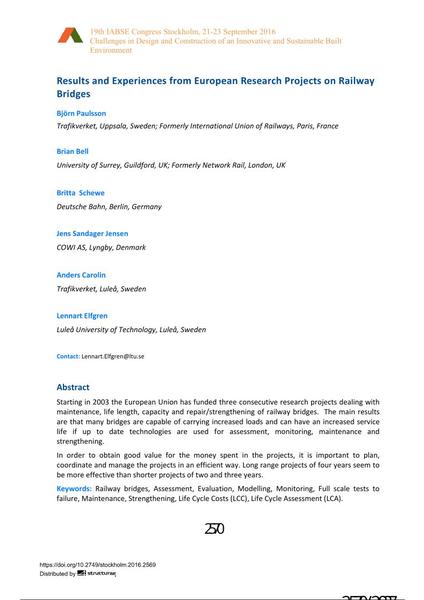Results and Experiences from European Research Projects on Railway Bridges

|
|
|||||||||||
Détails bibliographiques
| Auteur(s): |
Björn Paulsson
(Trafikverket, Uppsala, Sweden; Formerly International Union of Railways, Paris, France)
Brian Bell (University of Surrey, Guildford, UK; Formerly Network Rail, London, UK) Britta Schewe (Deutsche Bahn, Berlin, Germany) Jens Sandager Jensen (COWI AS, Lyngby, Denmark) Anders Carolin (Trafikverket, Luleå, Sweden) Lennart Elfgren |
||||
|---|---|---|---|---|---|
| Médium: | papier de conférence | ||||
| Langue(s): | anglais | ||||
| Conférence: | IABSE Congress: Challenges in Design and Construction of an Innovative and Sustainable Built Environment, Stockholm, Sweden, 21-23 September 2016 | ||||
| Publié dans: | IABSE Congress Stockholm, 2016 | ||||
|
|||||
| Page(s): | 2570-2578 | ||||
| Nombre total de pages (du PDF): | 9 | ||||
| Année: | 2016 | ||||
| DOI: | 10.2749/stockholm.2016.2569 | ||||
| Abstrait: |
Starting in 2003 the European Union has funded three consecutive research projects dealing with maintenance, life length, capacity and repair/strengthening of railway bridges. The main results are that many bridges are capable of carrying increased loads and can have an increased service life if up to date technologies are used for assessment, monitoring, maintenance and strengthening. In order to obtain good value for the money spent in the projects, it is important to plan, coordinate and manage the projects in an efficient way. Long range projects of four years seem to be more effective than shorter projects of two and three years. |
||||
| Mots-clé: |
ponts ferroviaires renforcement
|
||||

